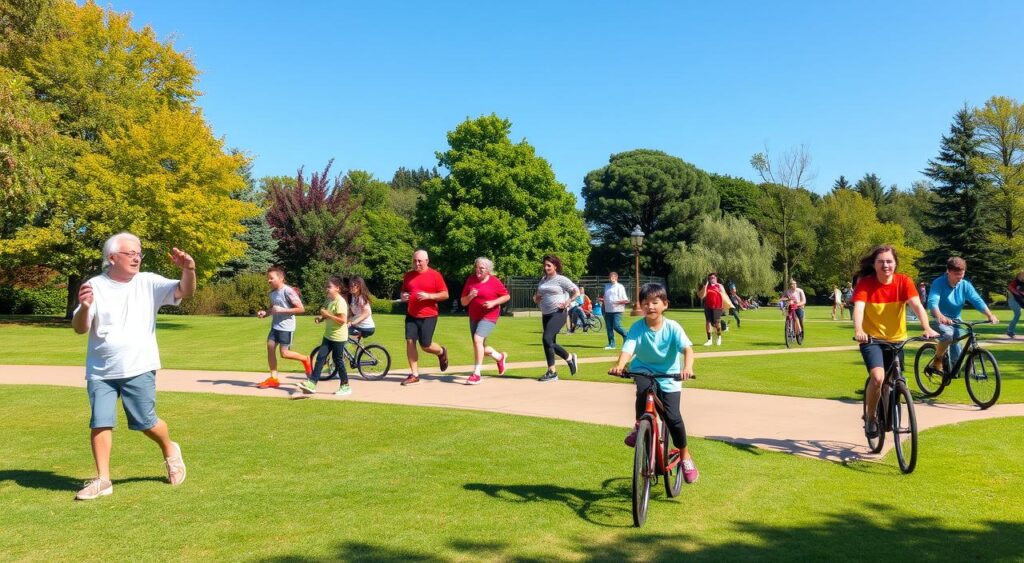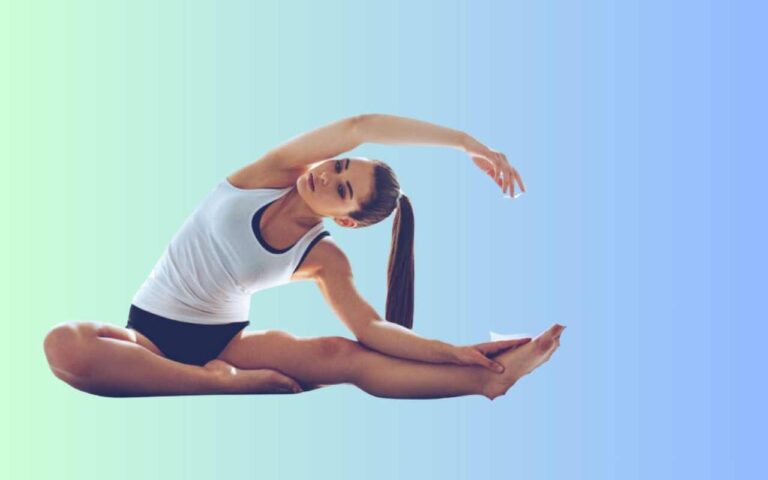Stay Active: Exercise for All Ages
Exercise for All Ages: Being active is good for people of all ages. It can lower your risk of heart disease, stroke, type 2 diabetes, and some cancers. It also boosts your strength, and balance, and helps you do everyday tasks on your own. (age and exercise)
Even doing 5 minutes of activity each day can be beneficial. You can gradually increase this amount over time. The main thing is to pick activities you like that suit your fitness level and needs. (best exercise)

Importance of Staying Active as You Age
As you get older, it’s key to keep moving for your health and happiness. Being active can lower your risk of serious health issues and boost your strength, balance, and brain power. Starting an age-appropriate exercise plan can greatly improve your health and wellness. (Exercise for All Ages)
The Universal Benefits of Exercise
Before delving into age-specific benefits, it’s essential to understand the universal advantages of regular physical activity. Exercise is a cornerstone of good health, contributing to:
Longevity: Numerous studies have shown that regular exercise is associated with a longer life expectancy. It reduces the risk of chronic diseases, enhances mobility, and improves overall quality of life.
Cardiovascular Health: Regular exercise strengthens the heart, improves circulation, and helps maintain healthy blood pressure levels. It reduces the risk of heart disease, stroke, and other cardiovascular conditions. (exercise best)
Weight Management: Physical activity burns calories and helps regulate body weight. It also boosts metabolism and improves muscle tone, making it easier to maintain a healthy weight.
Mental Health: Exercise has a profound impact on mental well-being. It releases endorphins, the body’s natural mood lifters, which help combat stress, anxiety, and depression. It also improves sleep quality and cognitive function.
Bone and Muscle Strength: Weight-bearing exercises, such as walking and strength training, are vital for building and maintaining bone density. Exercise also preserves muscle mass, which tends to decline with age.
“Routine exercise can help improve overall health and well-being as seniors age. Staying active can help prevent some age-related health conditions.” – National Institute on Aging
Being active has many benefits, from better heart health to stronger bones and joints. By making exercise a regular part of your life, you’re taking great steps to keep your health and wellness in top shape as you get older.
Types of Exercise for All Ages
Staying active is key at every life stage. It’s vital to mix different exercises in your routine. Aerobic or endurance activities boost your heart, lungs, and blood flow health. (Recommended exercise by age)
Aerobic or Endurance Exercises
Activities like brisk walking, swimming, and biking make your heart and lungs work harder. This brings more oxygen to your cells. These exercises can help prevent heart disease, diabetes, and some cancers. Try to move more and sit less throughout the day. (exercises to do everyday)
- Brisk walking
- Swimming
- Cycling
- Dancing
- Jogging or running
- Tennis or other racket sports
| Age Group | Recommended Aerobic/Endurance Activity | Time Commitment |
|---|---|---|
| Children (6-17 years) | At least 1 hour of physical activity per day | 60 minutes |
| Teens | At least 1 hour of physical activity per day | 60 minutes |
| Adults | 150 minutes of moderate-intensity exercise or 75 minutes of vigorous exercise per week, plus muscle strengthening | 150-300 minutes |
Being active and trying various fitness activities is great for your cardio activities and endurance exercises. It’s part of a healthy active lifestyle.

Exercise for All Ages: Strength Training
Strength training is key for any workout plan that suits your age. It makes daily tasks easier, like getting up or carrying groceries. It also boosts balance and helps prevent falls. You can use weights, resistance bands, or bodyweight exercises.
Start with light weights or resistance when you begin strength training. Then, slowly increase the weight as you get stronger. This helps your muscles adjust safely. Try to do strength exercises for all major muscles two times a week. Do one set of 12-15 reps for each exercise.
Many studies prove strength training is great for people of all ages and fitness levels. It keeps muscle mass, boosts bone density, helps with weight, and lessens chronic condition symptoms. It’s key to staying active, independent, and full of life as you get older. (Exercise for All Ages)
Adding functional training, age-appropriate workouts, and strength training to your routine keeps you healthy and active as you age. Begin with a simple program and slowly increase the intensity and time as you get stronger and more confident.
Enhancing Balance and Flexibility
As you get older, keeping your balance and flexibility is key. These exercises are low-impact and can boost your stability and coordination. They also help you move easily and lower the chance of falling.
Balance Exercises
Adding balance exercises to your daily routine can make you feel more stable. Try standing on one foot, walking heel-to-toe, or doing Tai Chi. These exercises test your balance and improve your coordination. (Exercise for All Ages)
- Standing on one foot: Hold for up to 30 seconds, then switch sides. Gradually increase the time as you get stronger.
- Heel-to-toe walk: Take small, controlled steps, placing your heel directly in front of your toes. Repeat for 10-20 steps.
- Tai Chi: This graceful, low-impact exercise improves balance, flexibility, and strength. Consider joining a Tai Chi class at your local fitness center or senior center.
Flexibility Exercises
Flexibility exercises can make everyday movements easier. They increase your range of motion, helping you reach and bend without strain. Focus on stretching your back, hips, and legs.
- Back stretch: Sit or stand tall, then gently twist your upper body to the right and left, holding each position for 20-30 seconds.
- Inner thigh stretch: Sit on the floor with your legs spread wide. Lean forward and reach for your toes, keeping your back straight.
- Ankle stretch: Sit with your legs extended, then gently flex and point your feet, feeling the stretch in your calves and ankles.
Start slowly and talk to your doctor if you have any worries. Adding balance and flexibility exercises to your routine can keep you independent and active.
What Is Fatty Liver: Causes, Symptoms, and Treatment
Getting Started with an Active Lifestyle
If you’re new to fitness routines or haven’t been active in a while, start slowly. Build up your active lifestyle over time. Even a 5-minute walk can be good for your health.
Choose activities you like, and aim for a mix of endurance, strength, balance, and flexibility exercises. This way, you’ll stay motivated and enjoy your workouts.
Think about joining a gym or recreation center with easy-to-use facilities and classes for beginners. If you have health concerns, talk to your doctor before starting an exercise program. Aim for at least 150 minutes of moderate-intensity aerobic activity each week. This can be biking, swimming, or brisk walking.
The main thing is to make physical activity a regular part of your day. If needed, break it into shorter sessions. Find ways to fit it into your daily life. With creativity and determination, you can build lasting fitness habits that improve your health and wellness.
FAQ
How can staying active benefit people of all ages?
Being active lowers your risk of heart disease, stroke, type 2 diabetes, and some cancers. It boosts your strength, and balance, and helps with daily tasks. Even 5 minutes of activity a week is good, and you can increase it over time. (Exercise for All Ages)
Why is physical activity especially important as you get older?
It helps prevent chronic conditions, improves strength and balance, and lifts your mood and brain function. Aim for 150 minutes of moderate aerobic activity like walking, swimming, or dancing weekly. Include muscle-strengthening exercises at least 2 times a week. (Exercise for All Ages)
What are the different types of exercise I should incorporate into my routine?
Endurance activities like walking, swimming, and biking boost your heart and lungs. Strength training helps with daily tasks. Balance and flexibility exercises are key for staying independent and avoiding falls. (Exercise for All Ages)
How should I get started with an active lifestyle?
Begin with small steps if you’re new to exercise or haven’t been active in a while. Pick activities you like and mix endurance, strength, balance, and flexibility exercises. Look for a gym or center with easy-to-use facilities and classes. Talk to your doctor before starting if you have health concerns. (Exercise for All Ages)








One Comment